
PREV ARTICLE
NEXT ARTICLE
FULL ISSUE
PREV FULL ISSUE
STACKING THE 1907 HIGH RELIEF DOUBLE EAGLESDave Wnuck's Making the Grade newsletter is always an interesting read. The December 6, 2018 issue addressed the topic of stacking the High Relief St. Gaudens double eagles. With permission we're republishing it here. Thanks. -Editor
I purchased it earlier this year. As I mentioned in an online coin chat room recently, this collection is a time capsule. It was formed by a president of a small bank in New England, who was employed from the 1920's through the early 1960's. It has sat in a safety deposit box since that time. He obviously was a bit of a collector. I suspect he had his tellers put aside any unusual coins and paper money they came across. Lots of really interesting stuff, but what might be the coolest (and certainly the items with the most monetary value) was this group of 3 high relief $20's. It was suggested in that online forum that I should try to see if they stack, since that was mentioned as one of the reasons the mint switched to the low relief design later in 1907. Good idea -- so I did so. There are very few times in life when I am blessed with having three raw, uncirculated high reliefs on my desk at one time. Counting this instance, there has been a total of one time so far. As you can see from the photo, they stacked just fine. No wobbling at all caused by the high relief design. It turns out, though, that "stacking" refers to the height of a pile of coins, not to the coins "wobbling." The height of a pile of 20 double eagles was the informal standard in bank counting rooms. This piece of information was explained to all of us in that chat room by numismatic researcher extraordinaire Roger Burdette (Isn't the Internet wonderful?). Roger actually produced a copy of a letter dated January 9, 1908 from engraver Charles Barber stating that a stack of 20 high relief coins was about the same height as a stack of 21 double eagles made in the conventional “low relief” manner. So that was the actual “stacking problem” – not the fact that the coins couldn't be successfully stacked. So – Roger Burdette knew this already, thanks to his brilliant in-depth research using original mint documents. I didn't know it though. And I suspect many of you out there in coin-land didn't know it either. The high relief double eagles stacked just fine. Their thickness simply “messed up” pile heights in bank counting rooms. That, and the difficulty of minting them – each coin required 3 blows from the press to bring up the details – doomed them to less than one year of production. But in that brief period they minted some of the most popular coins the US mint has ever produced. To read the complete newsletter, see:  Wayne Homren, Editor The Numismatic Bibliomania Society is a non-profit organization promoting numismatic literature. See our web site at coinbooks.org. To submit items for publication in The E-Sylum, write to the Editor at this address: whomren@gmail.com To subscribe go to: https://my.binhost.com/lists/listinfo/esylum All Rights Reserved. NBS Home Page Contact the NBS webmaster 
|
